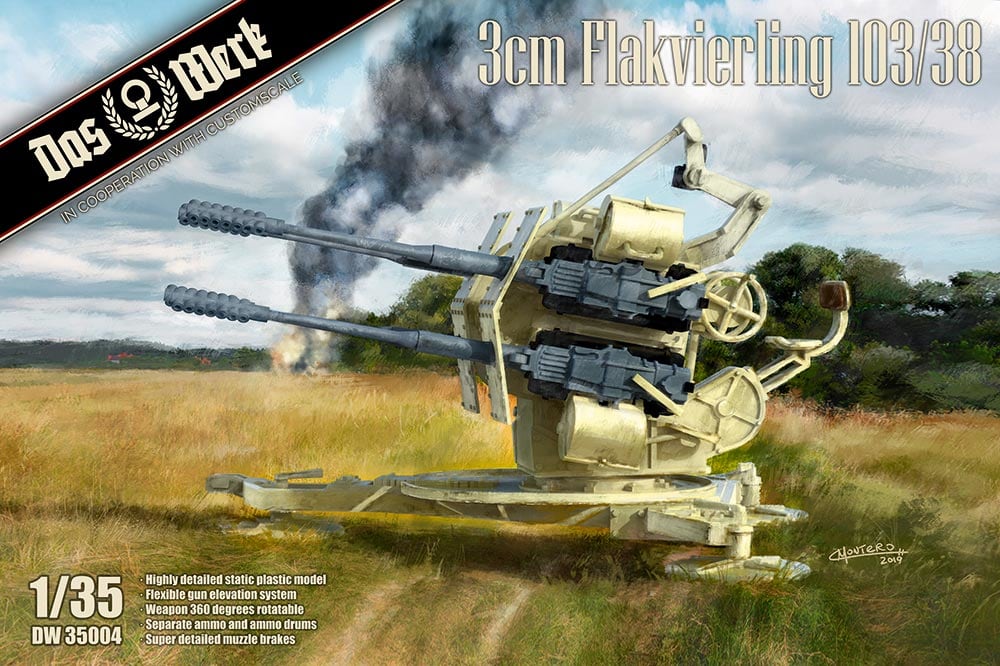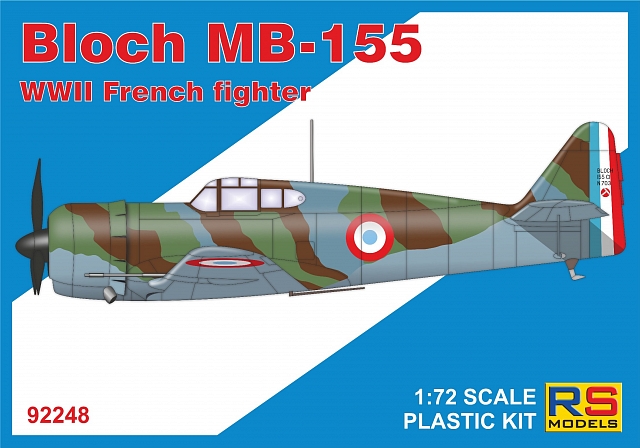Modely
Celkem 14 produktů
1/35 3cm Flakvierling 103/38. The Mk103/38 was a late-war, four-gun installation of the Mk103 3cm gun from Rheinmetall Borsig. The Mk103 was an electrically fired, recoil and gas-operated automatic cannon designed to be used as a dual-purpose weapon against air and ground targets.The Mk103 had a rate of fire of 280 rounds per minute using high explosive (HE) rounds, and 420 rounds per minute when firing Armor Piercing rounds.The experimental Mk103/38 four-gun installation proved troublesome due to fact that the mount was originally designed for the smaller 2cm Flak 38, and heavy vibration took it’s toll on both the equipment and the crew aiming the weapon.
1/35 3cm Flakvierling 103/38. The Mk103/38 was a late-war, four-gun installation of the Mk103 3cm gun from Rheinmetall Borsig. The Mk103 was an electrically fired, recoil and gas-operated automatic cannon designed to be used as a dual-purpose weapon against air and ground targets.The Mk103 had a rate of fire of 280 rounds per minute using high explosive (HE) rounds, and 420 rounds per minute when firing Armor Piercing rounds.The experimental Mk103/38 four-gun installation proved troublesome due to fact that the mount was originally designed for the smaller 2cm Flak 38, and heavy vibration took it’s toll on both the equipment and the crew aiming the weapon.
Model Kit vrtulník 7270 - MIL MI-26 Soviet Helicopter (1:72). Model letadla ke slepení. Velikost: 1:72; 55,5 cm. Balení obsahuje: 238 dílků ke slepení. Informace o originálu: Mi-26 je tím nejtěžším vrtulníkem, který dnes na oblohách celého světa létá. Celkem se ho vyrobilo 276 kusů. Mi-26 přijaly do svých služeb vojenské letecké složky států SNS, Indie, Malajsie, Peru, Jižní Koreje a v různých zemích je také využíván jako civilní helikoptéra. Barevné schéma (Potřebné barvy Humbrol): - 65, 33, 60, 27003, 56, 34, 120, 145, 103 Detaily modelu: Měřítko: 1:72 Počet dílů: 238 Délka: 555 mm Doporučeno pro děti od 10 let. Upozornění: Nebezpečí udušení! Výrobek obsahuje malé části. NEVHODNÉ PRO DĚTI DO 3 LET!
Model Kit vrtulník 7270 - MIL MI-26 Soviet Helicopter (1:72). Model letadla ke slepení. Velikost: 1:72; 55,5 cm. Balení obsahuje: 238 dílků ke slepení. Informace o originálu: Mi-26 je tím nejtěžším vrtulníkem, který dnes na oblohách celého světa létá. Celkem se ho vyrobilo 276 kusů. Mi-26 přijaly do svých služeb vojenské letecké složky států SNS, Indie, Malajsie, Peru, Jižní Koreje a v různých zemích je také využíván jako civilní helikoptéra. Barevné schéma (Potřebné barvy Humbrol): - 65, 33, 60, 27003, 56, 34, 120, 145, 103 Detaily modelu: Měřítko: 1:72 Počet dílů: 238 Délka: 555 mm Doporučeno pro děti od 10 let. Upozornění: Nebezpečí udušení! Výrobek obsahuje malé části. NEVHODNÉ PRO DĚTI DO 3 LET!
Bavlněná rouška s kapsou bílá / Cotton Face Mask with Filter pocket-White. Important: The mask should be washed at 90 ° C before first use. This will improve the protective properties and hygiene of the cotton. The mask is made of 100% cotton and is made of 2 layers of cotton with a filter pocket. We offer a maximum of 8 pieces per order for colleagues who do not have the opportunity or time to make masks themselves. The masks are sewn by a small clothing company from Liberec, which can continue to provide work for its employees, women and wives of friends and colleagues. We offer masks to support small business and they are not for our enrichment.
Plastikový model letadla 1/72 Bloch MB-155 5 decal v. for France, Luftwaffe. The Bloch MB.152 proved the definitive production model with nearly 500 produced. This version was powered by a Gnome-Rhone 14N-25/-49 series air cooled radial piston engine outputting at 1,100 horsepower depending on fitting. This was coupled to a three-bladed variable fixed propeller assembly. The combination supplied the aircraft with a top speed of 316 miles per hour with a range of 370 miles and service ceiling of 32,800 feet. 5 decal variants1. MB-155, No. 703, GC-1, Lt. Lefeuvre, Toulouse, June 19402. MB-155, No. 700, first prototype, France, December 19393. MB-155, No. 704, CO of 1 Escadrille, Capt. Coutaud, Agen, Algeria, June 19404. MB-155, No. 708, GC II/8, Vichy France Air-Force, 19415. MB-155, JG103, Luftwaffe, France 1943
Plastikový model letadla 1/72 Bloch MB-155 5 decal v. for France, Luftwaffe. The Bloch MB.152 proved the definitive production model with nearly 500 produced. This version was powered by a Gnome-Rhone 14N-25/-49 series air cooled radial piston engine outputting at 1,100 horsepower depending on fitting. This was coupled to a three-bladed variable fixed propeller assembly. The combination supplied the aircraft with a top speed of 316 miles per hour with a range of 370 miles and service ceiling of 32,800 feet. 5 decal variants1. MB-155, No. 703, GC-1, Lt. Lefeuvre, Toulouse, June 19402. MB-155, No. 700, first prototype, France, December 19393. MB-155, No. 704, CO of 1 Escadrille, Capt. Coutaud, Agen, Algeria, June 19404. MB-155, No. 708, GC II/8, Vichy France Air-Force, 19415. MB-155, JG103, Luftwaffe, France 1943
Plastikový model letadla 1/72 Avro Rota C.30A 4 decal v. for Czeczslovak.,RAF, Yugoslavia, Australia. The first production design in the series was the C.30, a radial-engined autogyro with a three-blade, 37 ft (11.3 m) rotor mounted on an aft-leaning tripod, the control column extending into the rear of the two cockpits. The engine was the five-cylinder, 105 hp (78 kW) Armstrong Siddeley Genet Major I used in the C.19 series. The fabric-covered fuselage carried an unbraced tailplane, without elevators but with turned-up tips. The port side of the tailplane had an inverted aerofoil section to counter roll-axis torque produced by the propeller. As with most autogyros, a high vertical tail was precluded by the sagging resting rotor, so the dorsal fin was long and low, extending well aft of the tailplane like a fixed rudder and augmented by a ventral fin. The wide-track undercarriage had a pair of single, wire-braced legs and a small tail wheel was fitted. This model flew in April 1933. It was followed by four improved machines designated C.30P (P here for pre-production) which differed in having a four-legged pyramid rotor mounting and a reinforced undercarriage with three struts per side. The rotor could be folded rearwards for transport. The C.30P used the more powerful (140 hp, 104 kW) seven-cylinder Armstrong Siddeley Genet Major IA radial engine.
Plastikový model letadla 1/72 Avro Rota C.30A 4 decal v. for Czeczslovak.,RAF, Yugoslavia, Australia. The first production design in the series was the C.30, a radial-engined autogyro with a three-blade, 37 ft (11.3 m) rotor mounted on an aft-leaning tripod, the control column extending into the rear of the two cockpits. The engine was the five-cylinder, 105 hp (78 kW) Armstrong Siddeley Genet Major I used in the C.19 series. The fabric-covered fuselage carried an unbraced tailplane, without elevators but with turned-up tips. The port side of the tailplane had an inverted aerofoil section to counter roll-axis torque produced by the propeller. As with most autogyros, a high vertical tail was precluded by the sagging resting rotor, so the dorsal fin was long and low, extending well aft of the tailplane like a fixed rudder and augmented by a ventral fin. The wide-track undercarriage had a pair of single, wire-braced legs and a small tail wheel was fitted. This model flew in April 1933. It was followed by four improved machines designated C.30P (P here for pre-production) which differed in having a four-legged pyramid rotor mounting and a reinforced undercarriage with three struts per side. The rotor could be folded rearwards for transport. The C.30P used the more powerful (140 hp, 104 kW) seven-cylinder Armstrong Siddeley Genet Major IA radial engine.
Plastikový model letadla 1/72 Mirage F.1AZ/CZ ‘The South African Commie Killers’. Mirage F.1 vděčí za svůj vznik soukromé iniciativě firmy Dassault. Prototyp vzlétl poprvé 23. prosince 1966. Sériové stroje byly zavedeny do výzbroje Armée de l´Air jako jednomístné stíhačky Mirage F.1C a dvoumístné cvičné stíhačky Mirage F.1B. V průběhu služby byla část strojů Mirage F.1 modifikována montáží tankovacího nástavce na verzi Mirage F.1C-200. Francouzské letectvo také používalo dvě průzkumné verze, Mirage F. 1CR a z Mirage F.1-200 přestavované Mirage F.1CT. Armée de l´Air dostalo celkem 246 kusů všech verzí Mirage F.1. Mirage F.1 se stala i úspěšným exportním artiklem. V Evropě ji zařadilo do výzbroje Španělsko a Řecko. V Jižní Americe se jediným uživatelem stal Ekvádor, zato v Africe a Asii byly Mirage F.1 zařazeny do výzbroje Gabonu, Jižní Afriky, Maroka, Libye, Iránu, Iráku, Jordánska, Kataru a Kuvajtu. Mirage F.1 se díky tomu zapojily do mnoha konfliktů po celém světě, od soubojů bez výstřelů řeckých stíhaček s tureckými protivníky, přes francouzské akce v Čadu, ekvádorské pohraniční konflikty s Peru, boje jihoafrických Mirage proti kubánským letounům z Angoly až po účast ve válce proti Iráku, kde létaly Mirage F.1 na obou stranách. Jihoafrická republika používala dvě verze Mirage F.1. F.1AZ byla bitevní verze bez radaru vybavená laserovým dálkoměrem. Verze F.1AC byla klasická stíhací verze, vybavená radarem. V osmdesátých letech dvacátého století se Jihoafrická republika angažovala v občanské válce v Angole a v konfliktu v Namibii. V bojích se úspěšně uplatnily i Mirage F.1 obou verzí. Nejúspěšnějším pilotem byl major J. Rankin. Na dvou různých strojích dosáhl dvou sestřelů angolských Migů.
Plastikový model letadla 1/72 Mirage F.1AZ/CZ ‘The South African Commie Killers’. Mirage F.1 vděčí za svůj vznik soukromé iniciativě firmy Dassault. Prototyp vzlétl poprvé 23. prosince 1966. Sériové stroje byly zavedeny do výzbroje Armée de l´Air jako jednomístné stíhačky Mirage F.1C a dvoumístné cvičné stíhačky Mirage F.1B. V průběhu služby byla část strojů Mirage F.1 modifikována montáží tankovacího nástavce na verzi Mirage F.1C-200. Francouzské letectvo také používalo dvě průzkumné verze, Mirage F. 1CR a z Mirage F.1-200 přestavované Mirage F.1CT. Armée de l´Air dostalo celkem 246 kusů všech verzí Mirage F.1. Mirage F.1 se stala i úspěšným exportním artiklem. V Evropě ji zařadilo do výzbroje Španělsko a Řecko. V Jižní Americe se jediným uživatelem stal Ekvádor, zato v Africe a Asii byly Mirage F.1 zařazeny do výzbroje Gabonu, Jižní Afriky, Maroka, Libye, Iránu, Iráku, Jordánska, Kataru a Kuvajtu. Mirage F.1 se díky tomu zapojily do mnoha konfliktů po celém světě, od soubojů bez výstřelů řeckých stíhaček s tureckými protivníky, přes francouzské akce v Čadu, ekvádorské pohraniční konflikty s Peru, boje jihoafrických Mirage proti kubánským letounům z Angoly až po účast ve válce proti Iráku, kde létaly Mirage F.1 na obou stranách. Jihoafrická republika používala dvě verze Mirage F.1. F.1AZ byla bitevní verze bez radaru vybavená laserovým dálkoměrem. Verze F.1AC byla klasická stíhací verze, vybavená radarem. V osmdesátých letech dvacátého století se Jihoafrická republika angažovala v občanské válce v Angole a v konfliktu v Namibii. V bojích se úspěšně uplatnily i Mirage F.1 obou verzí. Nejúspěšnějším pilotem byl major J. Rankin. Na dvou různých strojích dosáhl dvou sestřelů angolských Migů.





